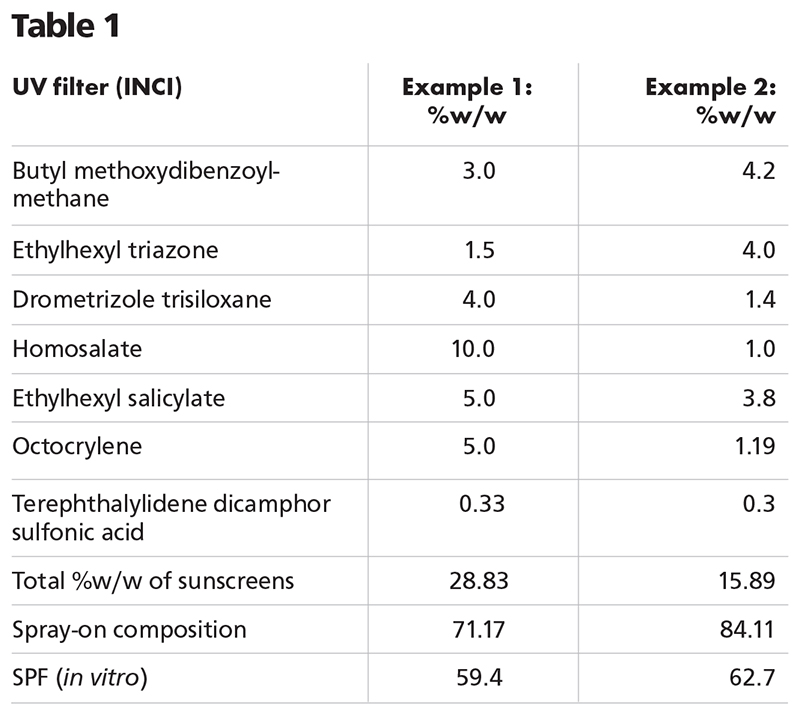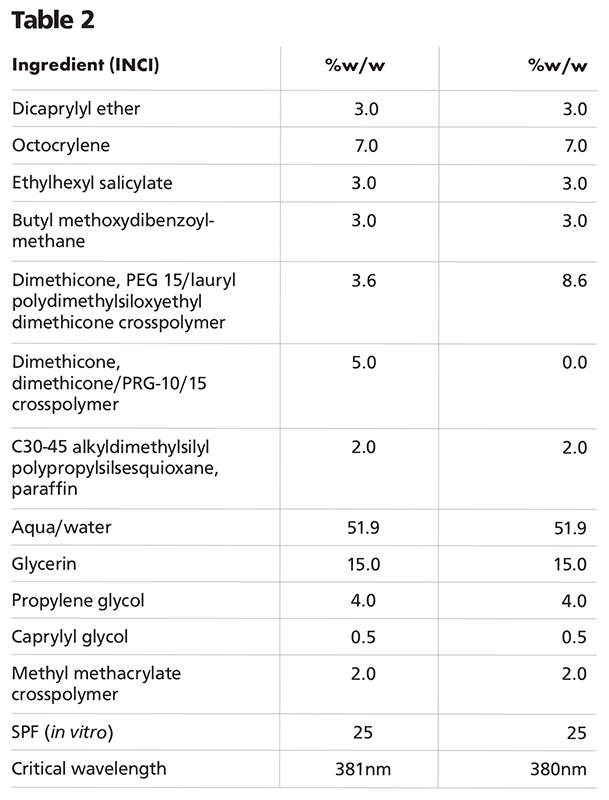As the trend for organic and natural beauty products continue to gain momentum, formulators in the sun care and self-tanning categories are taking notice.
Below are three patents that present novel formulations for organic and natural sun care and self-tanning products.
1. Sunscreen compositions having synergistic combination of UV filters
US Patent 9,572,759
Application No 14/750,299
Granted 21 February 2017
Assignee L’Oréal
The patent describes sunscreen compositions having a synergistic combination of ultraviolet (UV) light filtering agents that provide a high sun protection factor (SPF).
The combination of filters comprises butyl methoxydibenzoylmethane, ethylhexyl triazone, drometrizole trisiloxane, homosalate, ethylhexyl salicylate, octocrylene and terephthalylidene dicamphor sulfonic acid.
The maximum level of any one UV filter is cited as 6% and the maximum total level is 35% by weight, based on the total weight of the composition.
The applicants claim that it is desirable to achieve the best photoprotection efficacy with the lowest amount of UV filters and that they discovered ways to attain SPFs that were not previously attainable with such low amounts of overall UV filters.
This synergy is found when certain UV filters are combined in particular ratios and is illustrated table 1, which shows the SPF obtained when a spray-on composition containing the patented combination was in vitro tested.
2. Sunscreen composition containing high levels of liposoluble UV filters
US Patent 9,655,825
Application No 14/744,771
Granted 23 May 2017
Assignee L’Oréal
The patent describes a sunscreen emulsion composition with a water-releasing effect that includes an oil phase containing a liquid organic liposoluble UV filter and a solid organic liposoluble UV filter at a combined concentration from about 10% to about 25%.
The composition has an SPF of greater than or equal to 15 and a critical wavelength of greater than 370nm. In use, water is released from the emulsion in a plurality of droplets upon application of shear.
The preferred emulsifier system is dimethicone/PEG- 10/15 crosspolymer with PEG-15/lauryl polydimethylsiloxyethyl dimethicone crosspolymer although other silicone-based emulsifiers are named.
The PEG-15/lauryl polydimethylsiloxyethyl dimethicone crosspolymer entraps the water, which is released upon application to the skin, and it significantly enhances the aesthetics of the composition.
This emulsifier system is present in combination with a second emulsifier sold as Dow Corning 5225C with the INCI composition of cyclopentasiloxane and PEG/PPG-18/18 dimethicone.
The preferred liquid organic liposoluble UV filter consists of a combination of octocrylene, and ethylhexyl salicylate and the preferred solid organic liposoluble UV filter is butyl methoxydibenzoylmethane but many other UV filters are listed and incorporated in the patent.
The oil and aqueous phases may contain all those ingredients in typical use for this type of composition. The formulations in table 2 were deemed stable and they released water droplets when applied to the skin.

3. Composition with improved tanning effect
US Patent 8,986,718
Application No 13/435,610
Granted 24 March 2015
Assignee Coty Germany
Claimed is a cosmetic composition for use in tanning human skin comprising 0.05-2% caffeine; 0.01-1% glycine; 0.001-0.2% hydrolysed Citrus aurantium dulcis fruit extract; 0.05-0.5% sodium lactate methylsilanol; and 0.05-3% Mauritia flexuosa fruit oil, and up to 100% of dermatological or cosmetic auxiliaries selected from the group consisting of:
Water, vitamins, a mixture of the plant extracts of Angelica archangelica root, Camellia sinensis leaf, Pongamia pinnata seed and Coffee arabica seed, synthetic polymers, esters, ethers, fatty acids, monovalent and multivalent alcohols, silicones and silicates – all percentages being by weight and related to the total weight of the cosmetic composition.
The hydrolysed Citrus aurantium dulcis fruit extract is prepared by extraction with water at temperatures of 20-35°C. The Mauritia flexuosa fruit oil is obtained by cold pressing of the fruit pulp.
The fruit contains carotenoids and fatty acids such as oleic acid and palmitic acid. Sodium lactate methylsilanol is obtained by condensation of a synthetic derivative of silicon on lactic acid.
The silicon derivative is obtained by synthesis, while the lactic acid is obtained by fermentation from sugar. Caffeine is readily available as a solid white powder.
The active ingredients are incorporated in a composition that may also contain typical ingredients for this product type including water, vitamins, other plant extracts and mixtures of extracts, synthetic polymers, esters, ethers, fatty acids, monovalent and multivalent alcohols, silicones and silicates.
The preferred optional plant oil is red palm oil, which supports the tanning action, together with Bixa orellana seed extract. Other preferred optional ingredients are beta-carotene and alpha-tocopherol.




